Alaska is the largest US state. It’s so huge it has national parks bigger than some entire countries. Yet, it’s the state with the smallest population.
Alaska is famous for its stunning coastline of icebergs, glaciers, and fjords. More than a million people take a cruise to Alaska every year to witness its untouched beauty.
In addition to all the natural landscapes, the low human population means more wildlife settlements, especially birds.
In this article, we’re going to highlight some of the coolest birds you can spot while adventuring in Alaska, according to their predominant color, so stick around.
Red Birds in Alaska
American Robin

- Scientific name: Turdus migratorius
- Length: 7.9 – 11 inches
- Weight: 2.7 – 3 ounces
- Wingspan: 12.2 – 15.8 inches
The American Robin is a relatively big songbird. They have a round body and a fairly long tail. Their feathers are gray-brown, with prominent warm orange underpants. Their calls are cheerful and usually occur in the early mornings.
If you spot them during flight, the view from underneath will reveal a white patch that runs from their lower belly to the tip of their tails. Males will typically have darker heads than females.
This bird enjoys feeding on berries, earthworms, and insects. Its summer breeding grounds extend into the northern part of Alaska, all the way into the Brooks Range. They also extend westward to the edges of the Aleutian chain.
The residents of Alaska will sometimes mark the arrival of spring by when they see the first American Robin arrive. Some Robins stick around during mild winters, especially if there are leftover berries. However, if the weather is too cold, the birds will migrate to the south.
The Redpolls

- Scientific name: Carduelis flammea
- Length: 4.7 – 5.5 inches
- Weight: 0.4 – 0.7 ounces
- Wingspan: 7.5 – 8.7 inches
These birds are much smaller than the American Robin. They’re songbirds with small heads relative to their bodies, and a pointed seed-eating bill. Their tails are short and have a small, triangular notch at the end.
The Redpolls are brown and white and have a red forehead patch that is hard to miss. The males have a pale red vest on the chest and upper flanks. They’re equipped with a throat pouch to store seeds until they can eat them in warm, protected spots.
They usually travel in large flocks numbering in the hundreds. They feed primarily on tiny seeds using their well-adapted bills, but can occasionally eat small insects or buds.
Their zapping calls are hard to miss, especially when they gather in large groups. You may find them hanging upside down from small branches where they’re feeding.
Red Phalarope

- Scientific name: Phalaropus fulicarius
- Length: 7.9 – 8.7 inches
- Weight: 1.5 – 2.1 ounces
- Wingspan: 16.1 – 17.3 inches
These birds are small shorebirds, but they’re the largest of the phalaropes. Breeding females have a bright reddish-cinnamon body, while the males have a duller orange-red one.
There is a non-breeding variety with different coloration. It is smooth gray on the upper half of its body and white on the lower half.
They’re most commonly spotted swimming in the water, hunting for invertebrates. They can also be seen flying above open waters in small flocks.
Rufous Hummingbird

- Scientific name: Selasphorus rufus
- Length: 2.8 – 3.5 inches
- Weight: 0.1 – 0.2 ounces
- Wingspan: 4.3 inches
This is a small hummingbird with a straight, long bill. Their plumage is bright orange on the back and belly. They have a white chest and dark black wings, with an especially dark red throat. They’re often described as “hummingbirds that glow like a bed of coals”.
Like all hummingbirds, they have a darting flying style with great maneuverability. They hunt insects stuck on spider webs and others that they catch in flight. They also use their slender beaks to suck on nectar.
Though they’re commonly found in Southeast and Southcentral Alaska, these birds spend their winter very far to the south, usually in Mexico or even Panama. They’re known for their extreme long-distance migrations. In 2010, a female Rufous was banded in Florida and was recaptured in Alaska 3 months later. To this day, no longer hummingbird migration has been recorded!
Red-Breasted Nuthatch
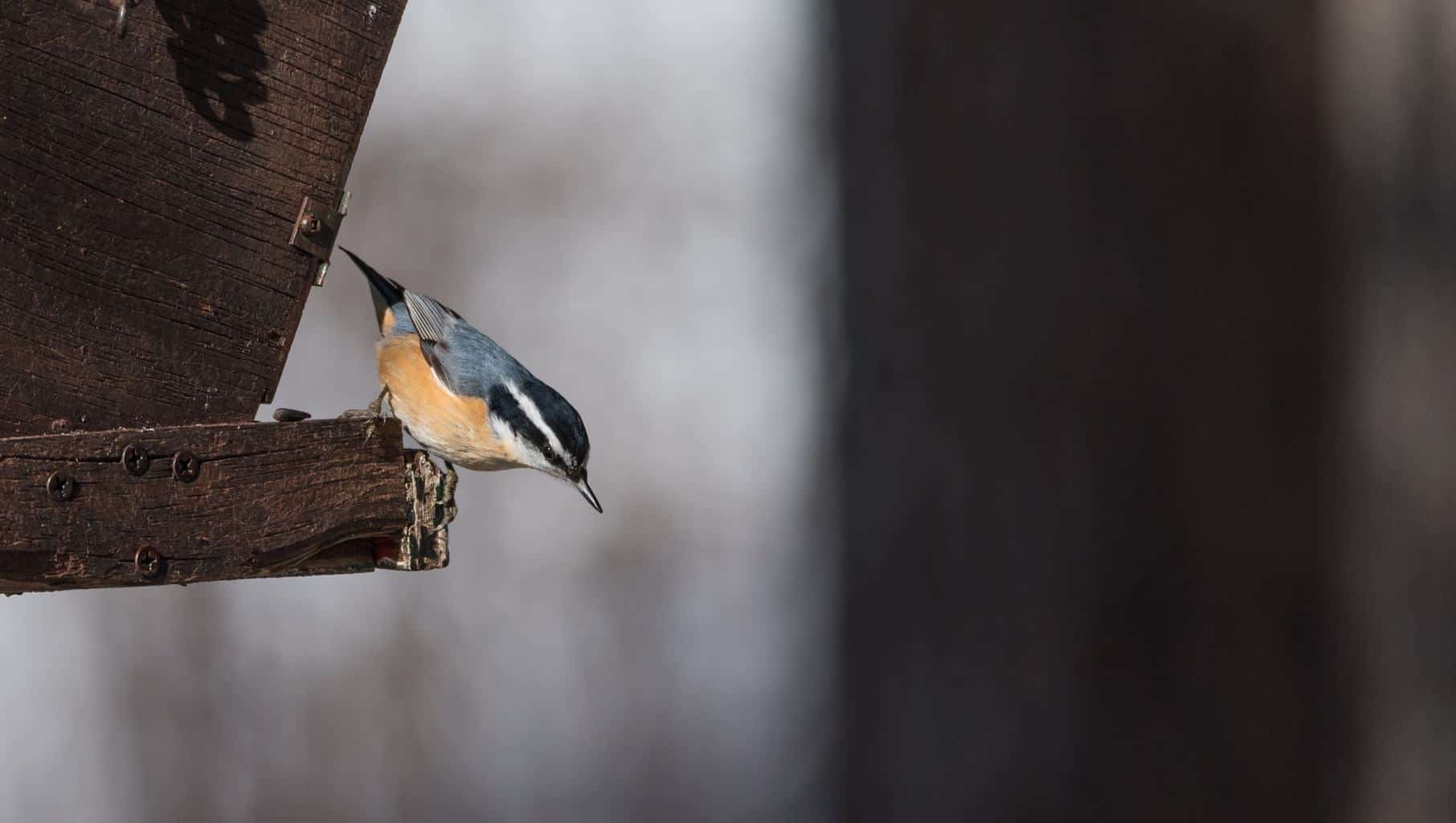
- Scientific name: Sitta canadensis
- Length: 4.3 inches
- Weight: 0.3 – 0.5 ounces
- Wingspan: 7.1 – 7.9 inches
This is a small bird with a serious-looking facial expression. They have short tails and necks, and their bodies are plump with broad, short wings. They have a blue-gray back with black and white striped heads. Their underparts are a rusty cinnamon color that is darker in males than females.
Their flight is short and bouncy, and they’re usually seen hanging out with woodpeckers and chickadees. You’re most likely to spot them near pine, hemlock, larch, maple, and other deciduous trees.
This bird is known for carrying resin globules and spreading them around the entrance hole of its nest. This is probably done to keep away predators.
Crossbills

- Scientific name: Loxia curvirostra
- Length: 7.8 inches
- Weight: 1.4 – 1.9 ounces
- Wingspan: 10.6 – 11.4 inches
The most common feature this bird has is its unusual bill. It doesn’t fully close but rather crosses when closed, which helps the bird reach the seeds inside of cone skeletons.
Grown males have a brick-red plumage. The wings and tail may be a bit darker. Females are mostly brown above and pale with brown streaks underneath.
They mainly feed on conifer seeds, but will occasionally eat weeds, buds, and small insects.
These birds are most commonly found in Southeastern Alaska, and their breeding and settlements depend greatly on the quality and availability of food rather than temperature. However, because of climate change, they sometimes have to migrate even there’s good food available.
Blue Birds In Alaska
Steller’s Jay

- Scientific name: Perisoreus canadensis
- Length: 11.8 – 13.4 inches
- Weight: 3.5 – 4.9 ounces
- Wingspan: 17.3 inches
These are relatively large songbirds with big heads and bills. They’re most famous for a crest that sits on top of their head and looks very much like a mohawk! The head is pitch black, and the rest of the body is blue with some patterning on the wings. There are noticeable white markings on the face as well.
These birds are considered smart and curious. They fly carefully and explore the forest canopy with great composure.
They feed on nuts, acorns, seeds, insects, berries, eggs, and newborn chicks. They may also scavenge on carcasses. These birds always accept handouts, so you may want to keep a few nuts in your pocket!
Mountain Bluebird
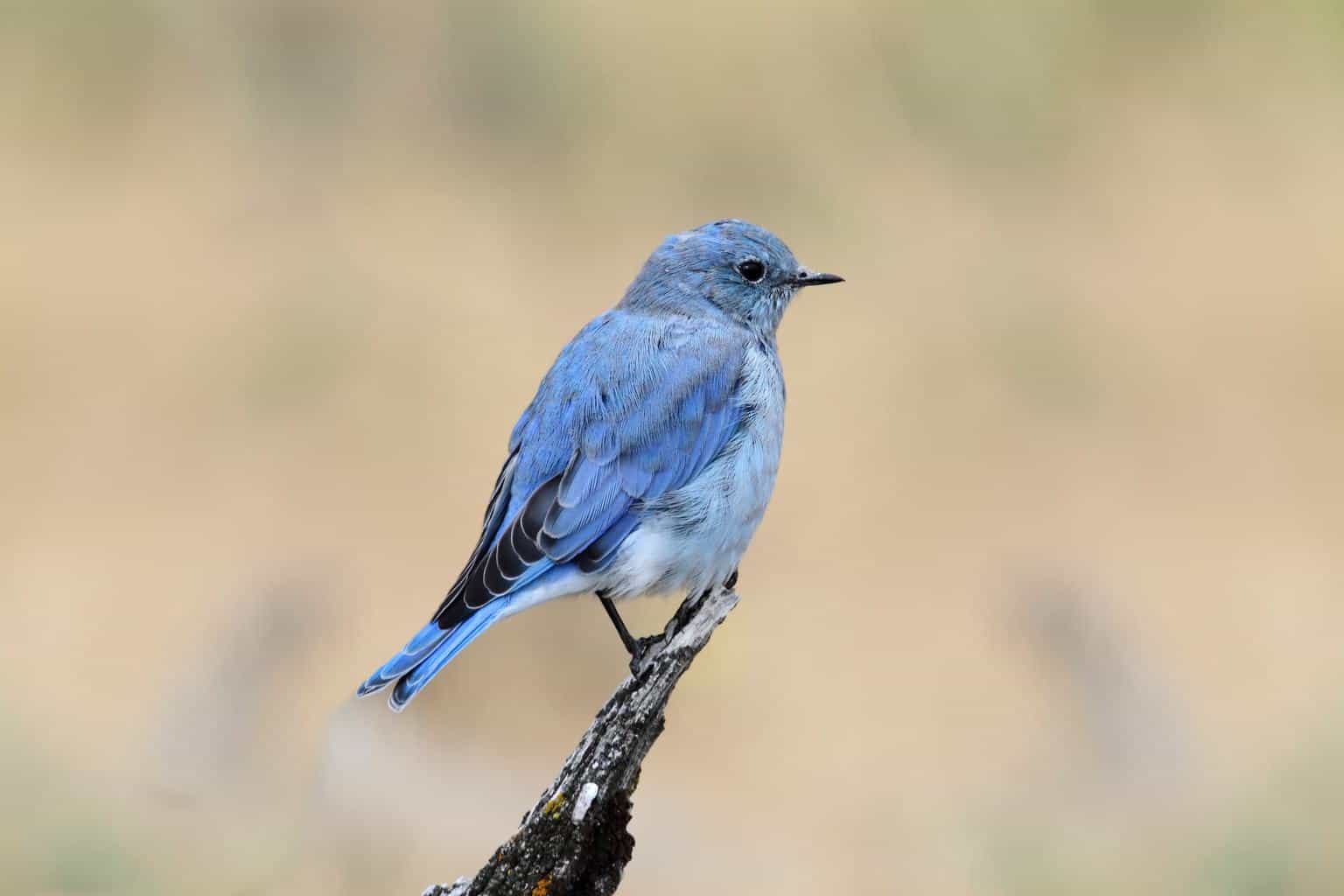
- Scientific name: Sialia currucoides
- Length: 6.3 – 7.9 inches
- Weight: 1.1 ounces
- Wingspan: 11.0 – 14.2 inches
This is a small thrush with relatively large wings. The males are a magnificent sky blue all over, while the females are mostly brown or gray with hints of pale blue on the wings and tail.
These birds hover and pounce onto insects like large predatory birds. During the winter, they usually gather in flocks and search for berries, especially the juniper variety.
They usually migrate to Northwestern Alaska for breeding and can be found in open spaces and areas high above sea level. Their call is a low “tru-lee” sound.
Green Birds In Alaska
Violet-Green Swallow

- Scientific name: Tachycineta thalassina
- Length: 4.7 inches
- Weight: 0.5 ounces
- Wingspan: 10.6 inches
The Violet-Green swallow is a bird with truly beautiful colors. When you first look at them, they appear to be dark above and white underneath. However, under good lighting, you’ll see their magnificent iridescent violet lower back and their greenish-bronze upper back. They’re relatively small birds with wide, pointed wings. Their wings easily stretch back beyond their slightly forked tails.
They’re social birds that can be seen with other swallows. They’re usually seen flying over bodies of water searching for flying insects to eat.
Yellow-Bellied Flycatcher

- Scientific name: Empidonax flaviventris
- Length: 5.1 – 5.9 inches
- Weight: 0.3 – 0.6 ounces
- Wingspan: 7.1 – 7.9 inches
This is a small flycatcher with relatively large eyes. It has a short tail and a small, wide bill. It’s mostly olive-yellow that gets darker on the back and wings. However, the underparts are a lighter yellow starting from the chin downwards to the lower belly.
This bird breeds in spruce forests and is usually found in dense, wet areas. They hang in the middle and lower canopy to quickly grab an insect. Their calls are soft and sound like a “pwee.”
Orange Birds In Alaska
Black-Headed Grosbeak
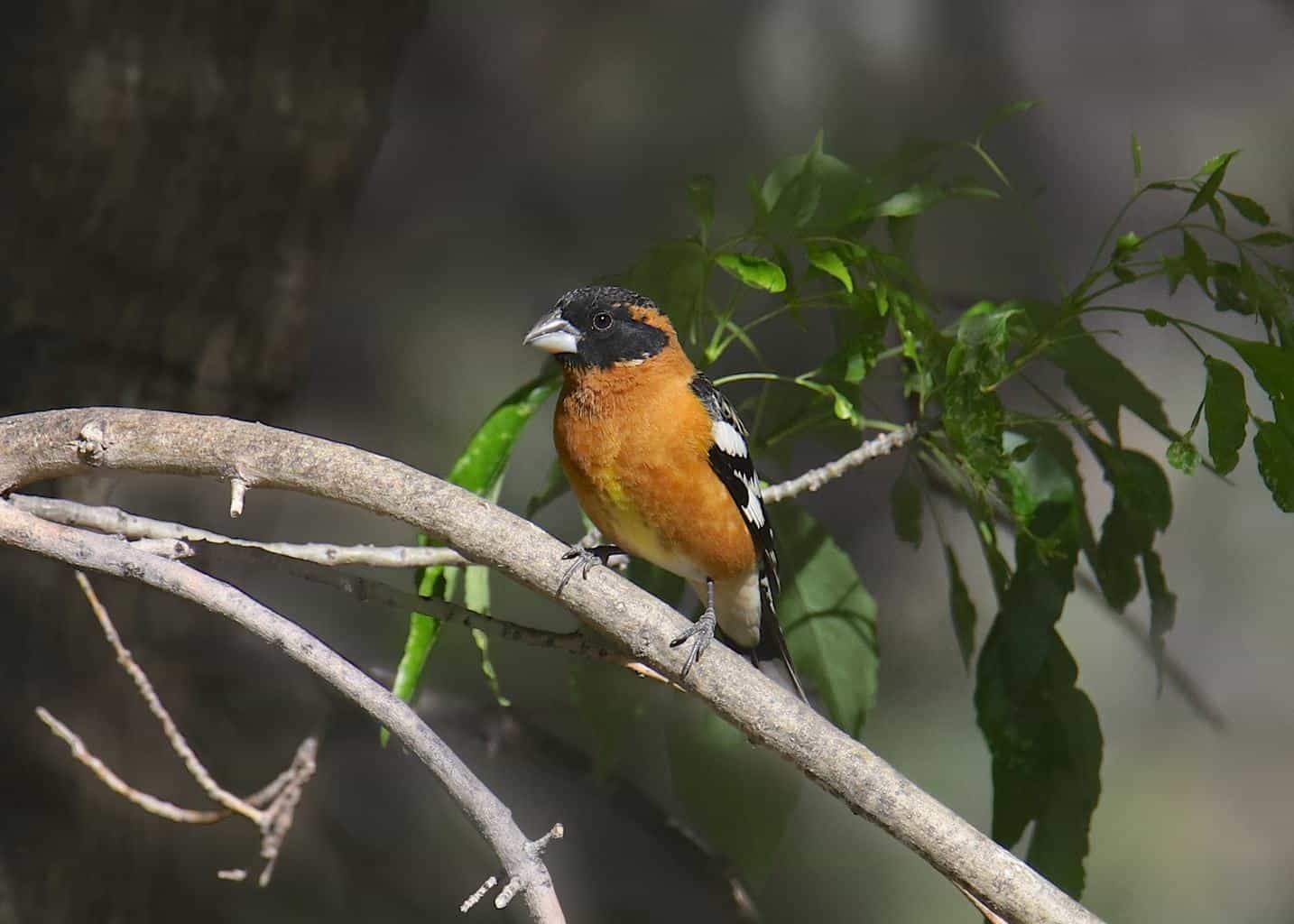
- Scientific name: Pheucticus melanocephalus
- Length: 7.1 – 7.5 inches
- Weight: 1.2 – 1.7 ounces
- Wingspan: 12.6 inches
These are large songbirds with big bills. The beaks are conical and start out thick at the base, then taper off. Breeding males are cinnamon orange, with black heads and wings. Females and non-breeding males, however, are brown above, with some warm orange underneath. They all have gray beaks and yellow underwings.
These birds reside in a variety of places. They can be found around springs, mountainous areas, and in the woods, and tend to have a sharp “eek” call that’s hard to miss.
Bullock’s Oriole

- Scientific name: Icterus bullockii
- Length: 6.7 – 7.5 inches
- Weight: 1.0 – 1.5 ounces
- Wingspan: 12.2 inches
This is a medium-sized songbird. They have sharp, point bills and long tails. The males are bright orange, with a black back, a black throat, and a black line through their eyes. Females and younger males are a lighter shade of orange.
These birds feed on caterpillars, nectar, and small fruits. They can be found in oak woodlands and orchards.
Orchard Oriole
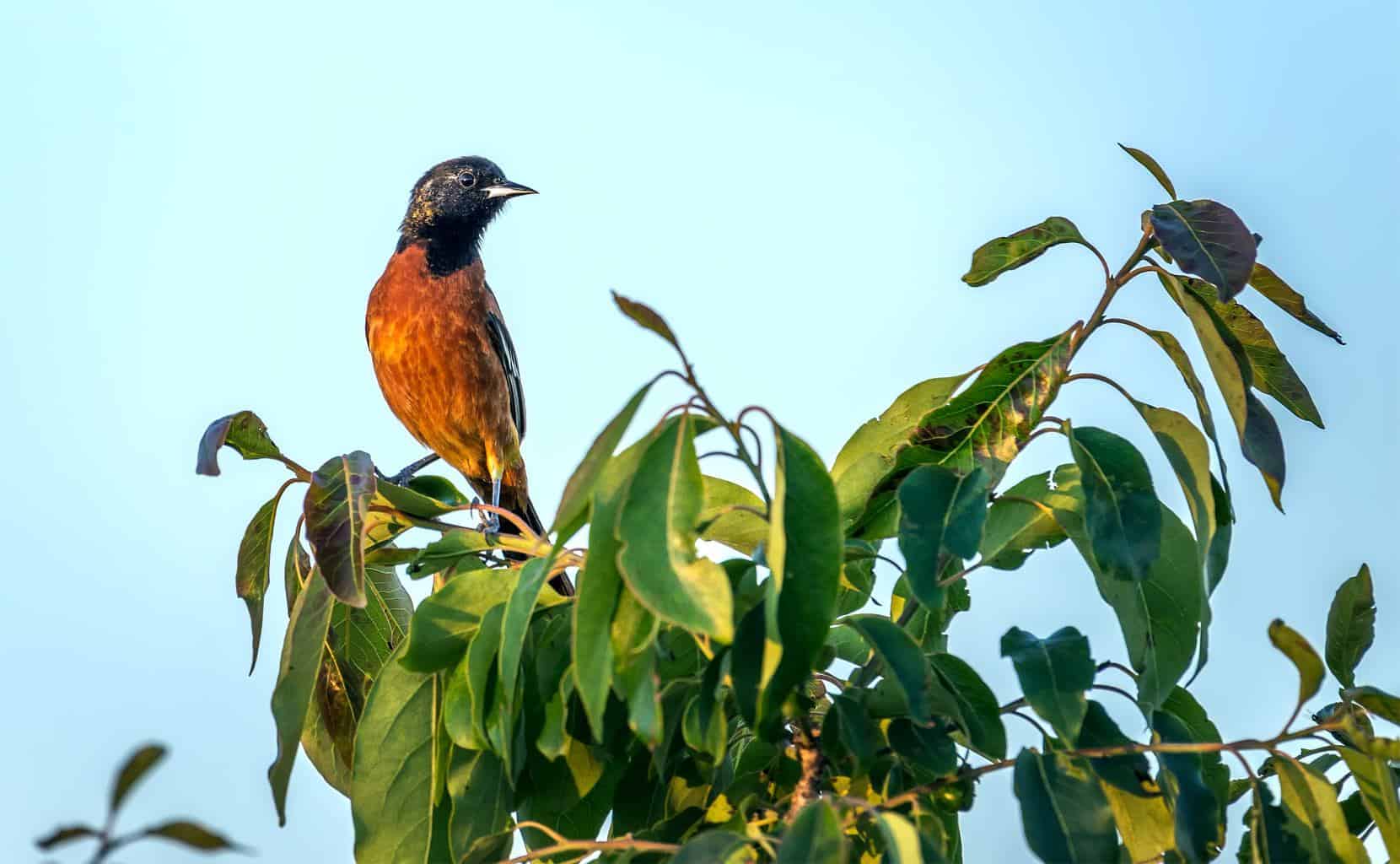
- Scientific name: Icterus spurius
- Length: 5.9 – 7.1 inches
- Weight: 0.6 – 1.0 ounces
- Wingspan: 9.8 inches
These are slim songbirds with a sharp, thin bill. They have medium-sized tails. The males are charcoal black on the head and back. However, they have a rich reddish-chestnut underneath. The females and younger males are greenish-yellow with no black coloring.
These birds feed on insects found in treetops. They also feed on nectar and berries. They occasionally welcome feeders with orange slices or jelly. They can be found on river banks and in parks and orchards.
Varied Thrush
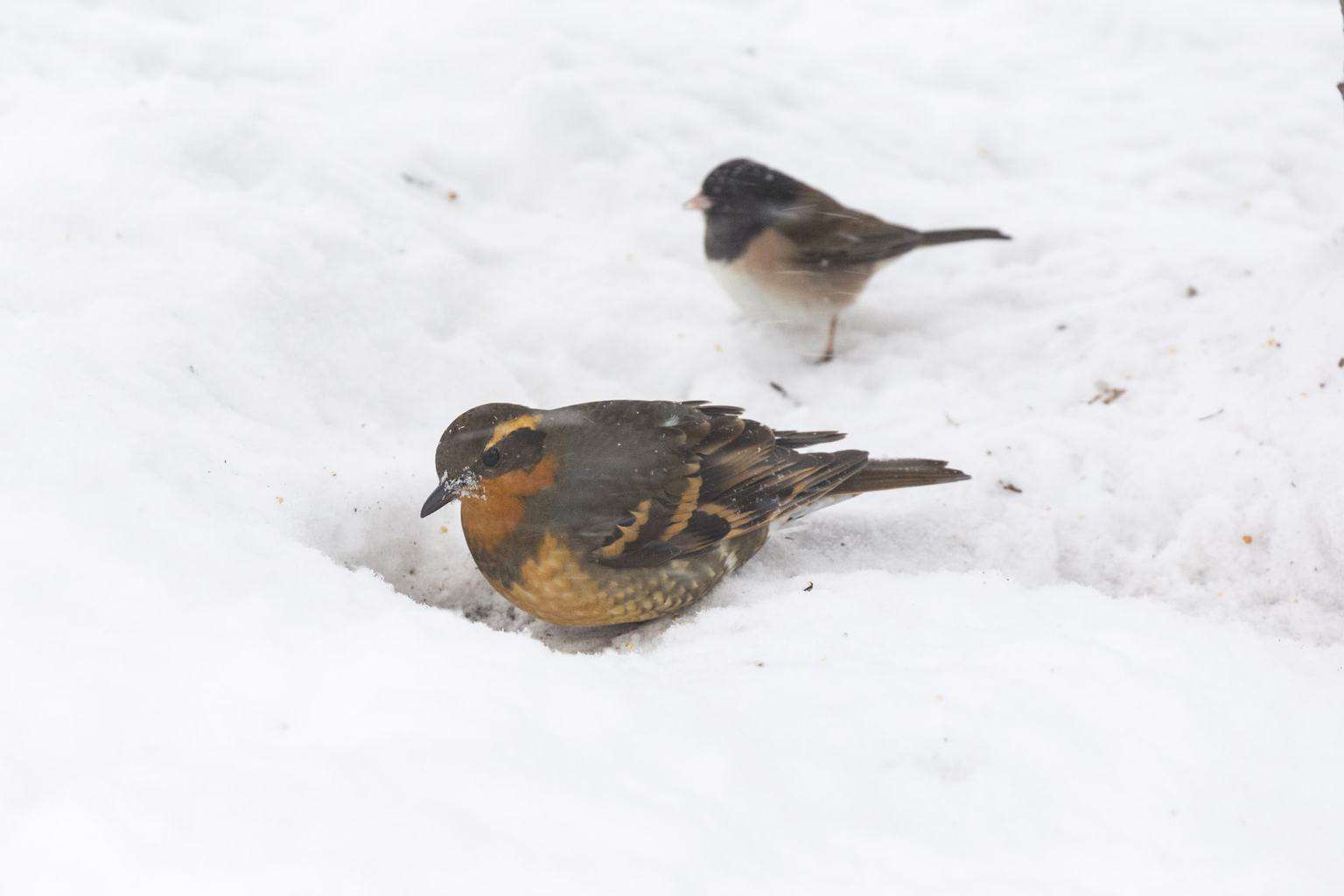
- Scientific name: Ixoreus naevius
- Length: 7.5 – 10.2 inches
- Weight: 2.3 – 3.5 ounces
- Wingspan: 13.4 – 15.0 inches
These are chunky songbirds with round heads and straight bills. They have long legs and are usually spotted standing horizontally.
The males are a dark blue-gray on the back and a burnt orange on the chest and belly. They have a prominent black line through their eyes, and their wings have some orange feathers. The females are similar to the males but their back is paler.
These birds eat insects during the summer but prefer nuts and fruits during the winter. The males are famous for their trilling songs.
Yellow Birds In Alaska
Yellow-Headed Blackbird

- Scientific name: Xanthocephalus xanthocephalus
- Length: 8.3 – 10.2 inches
- Weight: 1.6 – 3.5 ounces
- Wingspan: 16.5 – 17.3 inches
This is a fairly large bird that has a big head and a cone-shaped bill. Its colors are strikingly contrasting. The males have black bodies with bright yellow heads and chests. They also have white patches on their wings that are quite visible. Females and younger males are brown and have duller yellow coloring than the breeding males.
They feed on invertebrates from the water, insects, seeds, and grains. They breed and roost over freshwater areas with lots of vegetation.
Horned Lark
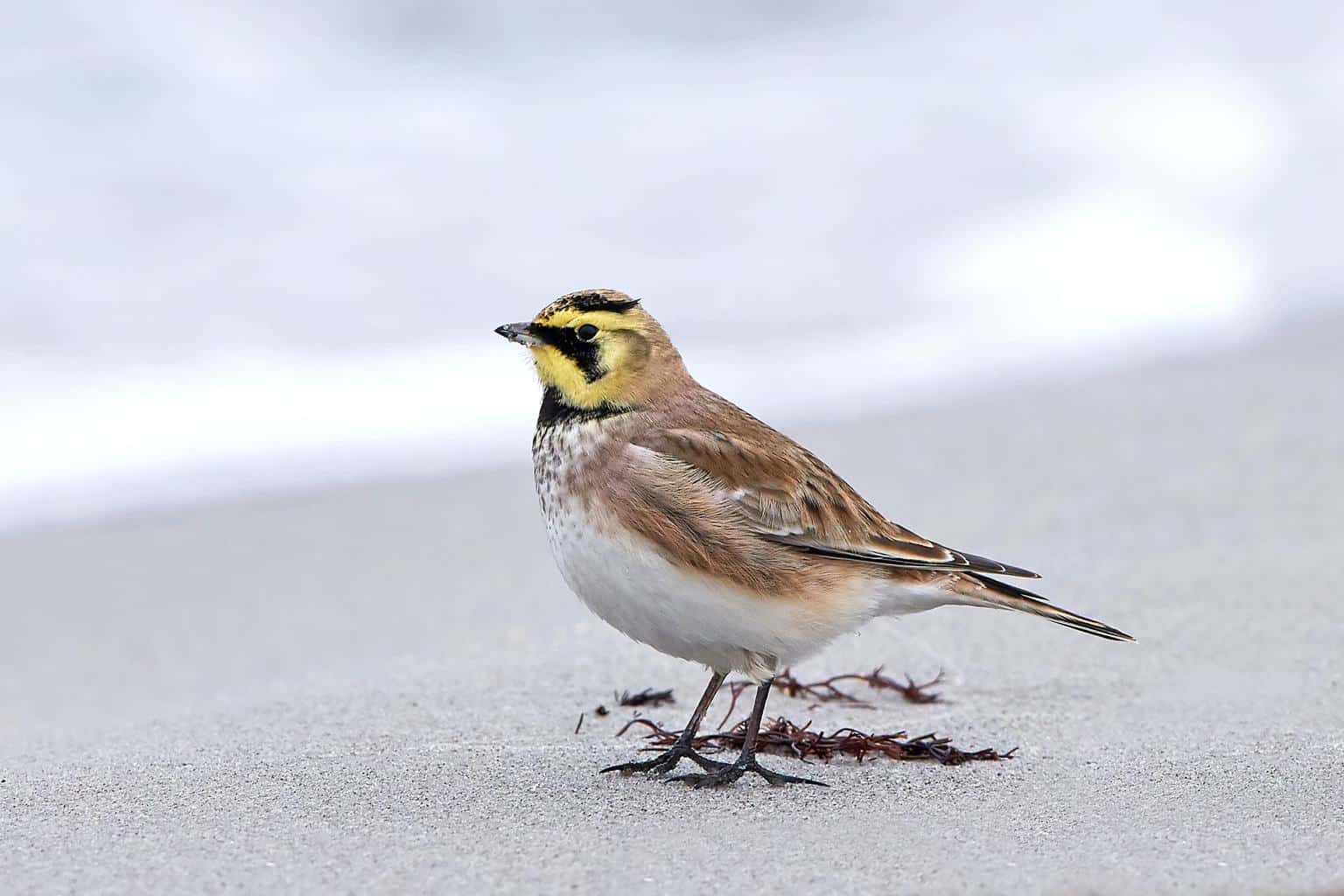
- Scientific name: Eremophila alpestris
- Length: 6.3 – 7.9 inches
- Weight: 1.0 – 1.7 ounces
- Wingspan: 11.8 – 13.4 inches
These are small songbirds with short necks and thin bills. They have round heads that sometimes show their “horns” of feathers sticking up. The males are rusty brown above, with a yellow face that has a curved black mask. Their underparts are mostly white. The females are similar in color but have less definition.
They travel and feed in huge flocks. They like eating insects and small seeds. You can spot them in areas with low vegetation.
Embark on a journey to learn about Alaska’s Small Birds right here!
Cape May Warbler
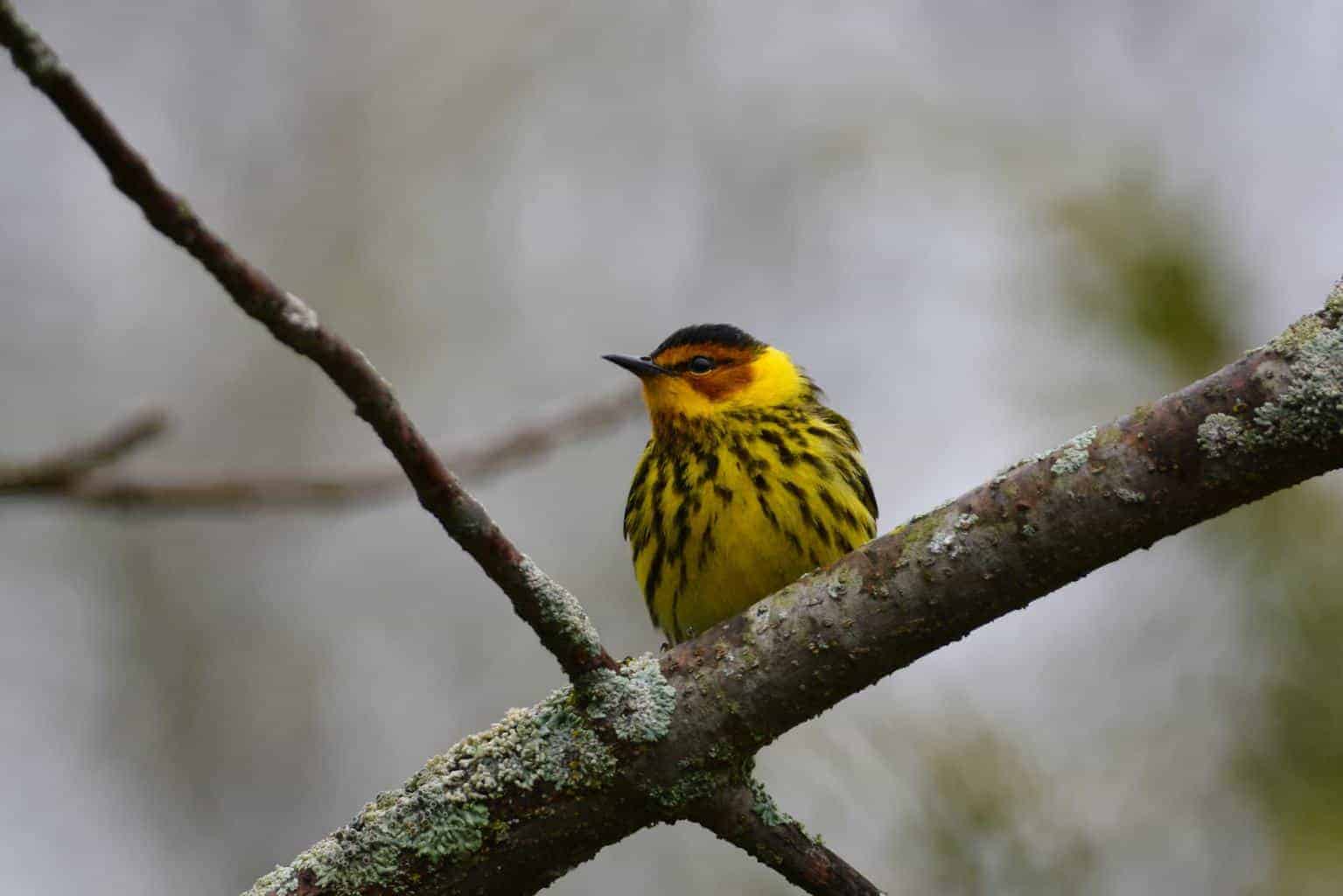
- Scientific name: Setophaga tigrina
- Length: 4.7 – 5.1 inches
- Weight: 0.4 – 0.5 ounces
- Wingspan: 7.9 – 8.7 inches
This small bird has a decurved bill. Adult males show rich yellowish olive above, with black stripes on the chest and belly that look very much like a tiger’s.
These birds like to feed on insects, suck on nectar from flowers, and eat fruits occasionally. You can find them in a variety of forested and shrubby areas.
Magnolia Warbler
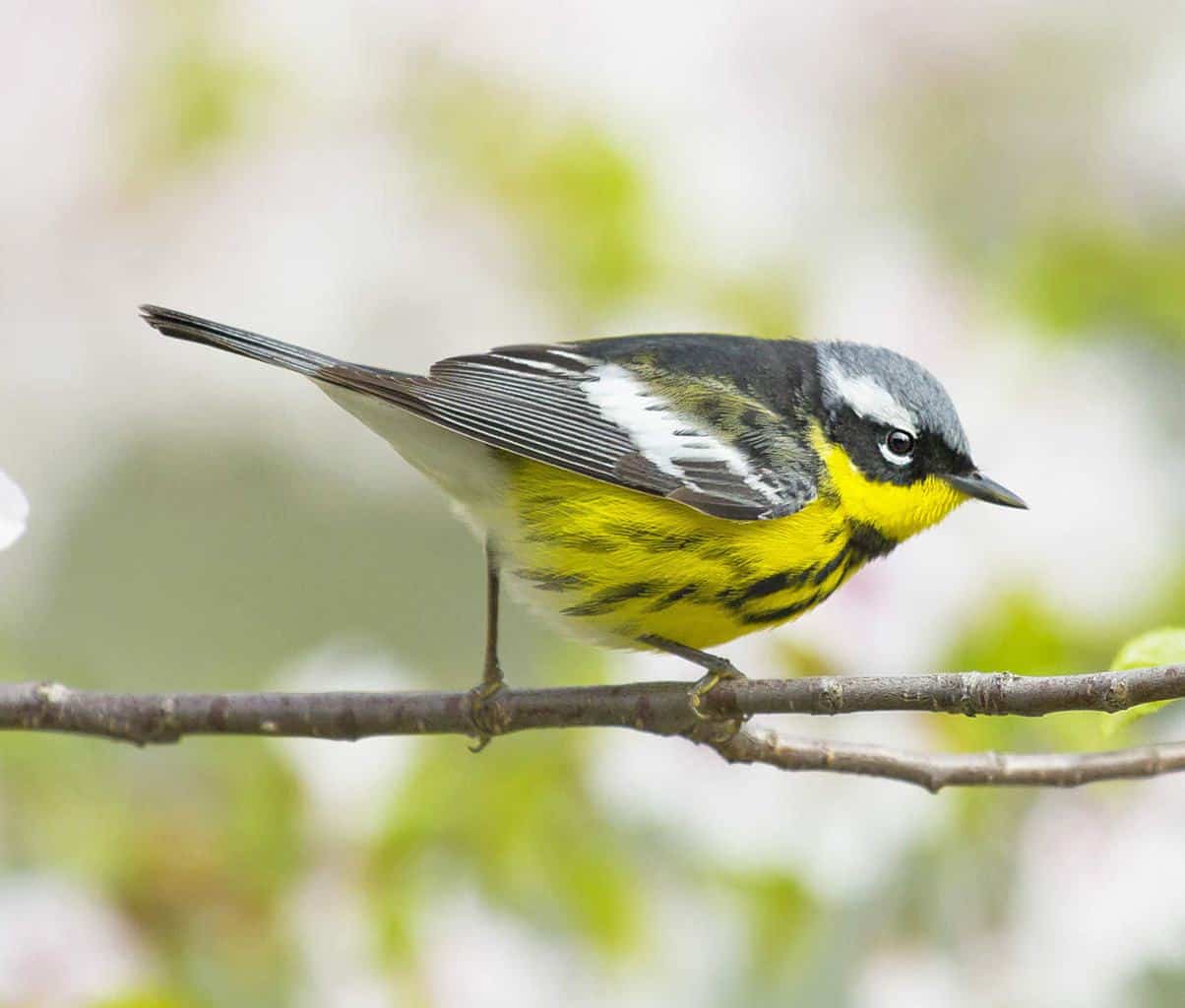
- Scientific name: Setophaga magnolia
- Length: 4.3 – 5.1 inches
- Weight: 0.2 – 0.5 ounces
- Wingspan: 6.3 – 7.9 inches
This is a small bird with a tiny bill and a large tail. The males are gray and black above with a white wing patch. They have a bright yellow chin and underparts with some black streaks. The females have gray heads and a white eye-ring.
This bird mainly feeds on insects and makes a display of flashing its tail wide, showing some white patches. They can be found in forests with dense vegetation.
Wilson’s Warbler

- Scientific name: Cardellina pusilla
- Length: 3.9 – 4.7 inches
- Weight: 0.2 – 0.3 ounces
- Wingspan: 5.5 – 6.7 inches
This bird is an even smaller warbler. These have thin bills and almost no neck. Their bodies are round and their legs are short. The males are yellowish-olive on the back and bright yellow on the chest and belly. They have a black spot on their head where you’d expect human hair to grow! Females are similar but show variations with the black spot on the head.
These birds spend a lot of time in the understory grabbing insects from foliage. They usually breed in mountain meadows close to streams but can use several other spots.
Yellow-Rumped Warbler

- Scientific name: Setophaga coronata
- Length: 4.7 – 5.5 inches
- Weight: 0.4 – 0.5 ounces
- Wingspan: 7.5 – 9.1 inches
These are larger than Wilson’s warblers and have a pointed bill. Both males and females are gray during the summer, with white stripes on their wings. They have a yellow lower back and a yellow chin.
They like moving into residential areas and parks during the fall and winter. They like feeding on wasps, caterpillars, spiders, and other insects. During the winter, they may eat berries and juniper.
Blue-Winged Warbler

- Scientific name: Vermivora cyanoptera
- Length: 4.3 – 4.7 inches
- Weight: 0.3 ounces
- Wingspan: 5.9 inches
These are small warblers with sharp, black, pointy bills. They have a black line across their eyes that gives them a sharp expression. Adult males are bright yellow on the chest and belly, but yellow-green on the back. The females are paler.
They dangle from shrubs like chickadees, hunting insects in this position. The males call and sing during the breeding season.
Other Birds In Alaska
Willow Ptarmigan
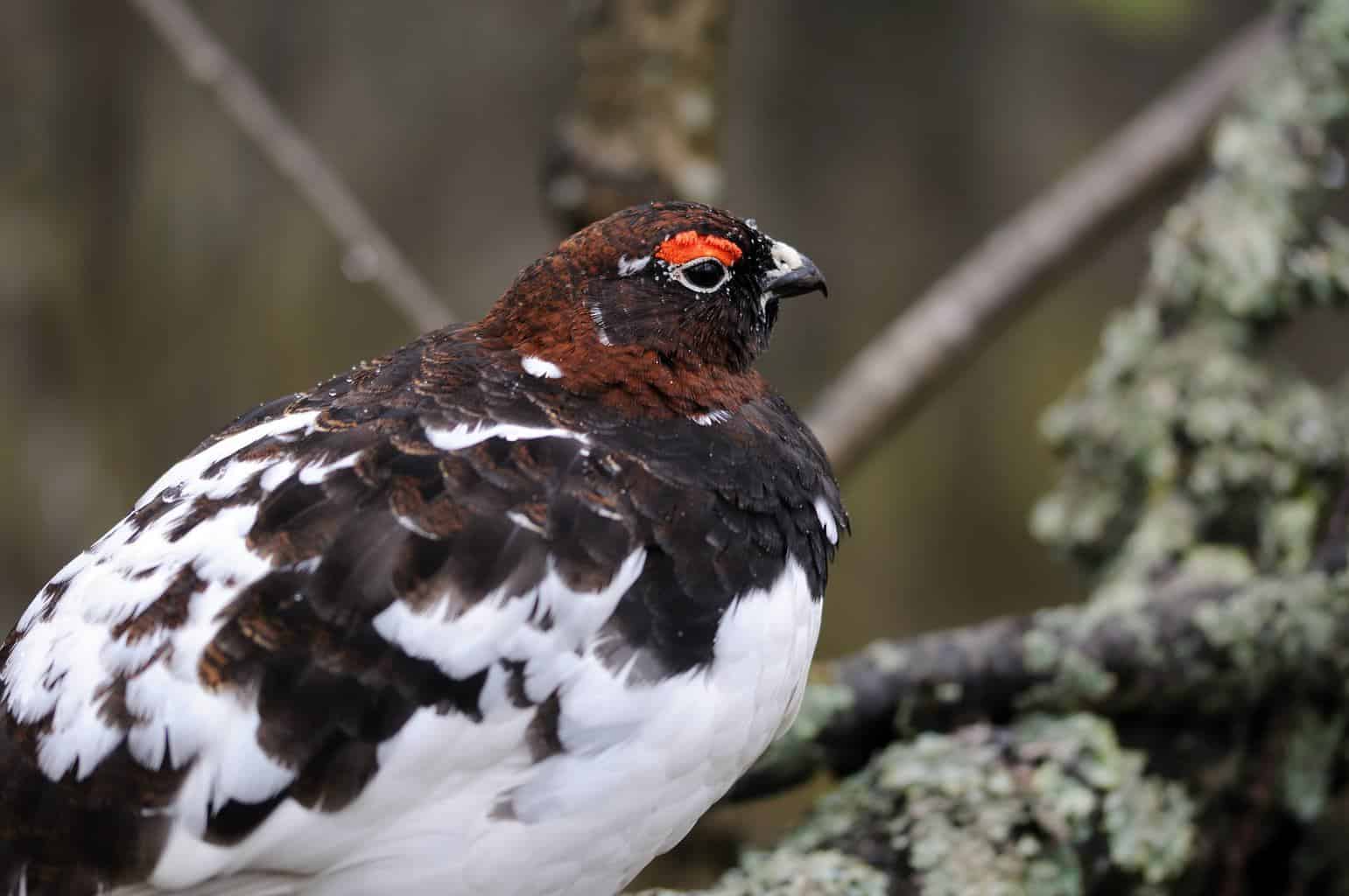
- Scientific name: Lagopus lagopus
- Length: 13.8 – 17.1 inches
- Weight: 19.0 – 23.6 ounces
- Wingspan: 23.6 – 24.4 inches
These are large, chicken-like birds that have short necks. They have a small, black bill and large feet. Young ptarmigans are almost fully white, while the breeding males have a long, reddish-brown neck and dark tails. Breeding females are mottled in dark and light brown.
These birds forage by slowly walking and picking willow buds and insects from the ground, much like a domestic chicken.
Trumpeter Swan

- Scientific name: Cygnus buccinator
- Length: 54.3 – 62.2 inches
- Weight: 271.6 – 448.0 ounces
- Wingspan: 79.9 inches
Probably the largest bird on our list, this is the classic-looking swan with a long neck. They have a large bill that slopes from the forehead to the tip. They also have relatively small heads for their size. The adults are entirely white, with just a black bill and black legs. Young swans are gray-brown.
These birds forage in shallow waters and dip their heads under the surface to eat aquatic vegetation. They also may visit fields to eat leftover grains. You’re very likely to find them in shallow lakes or rivers.
Canada Jay
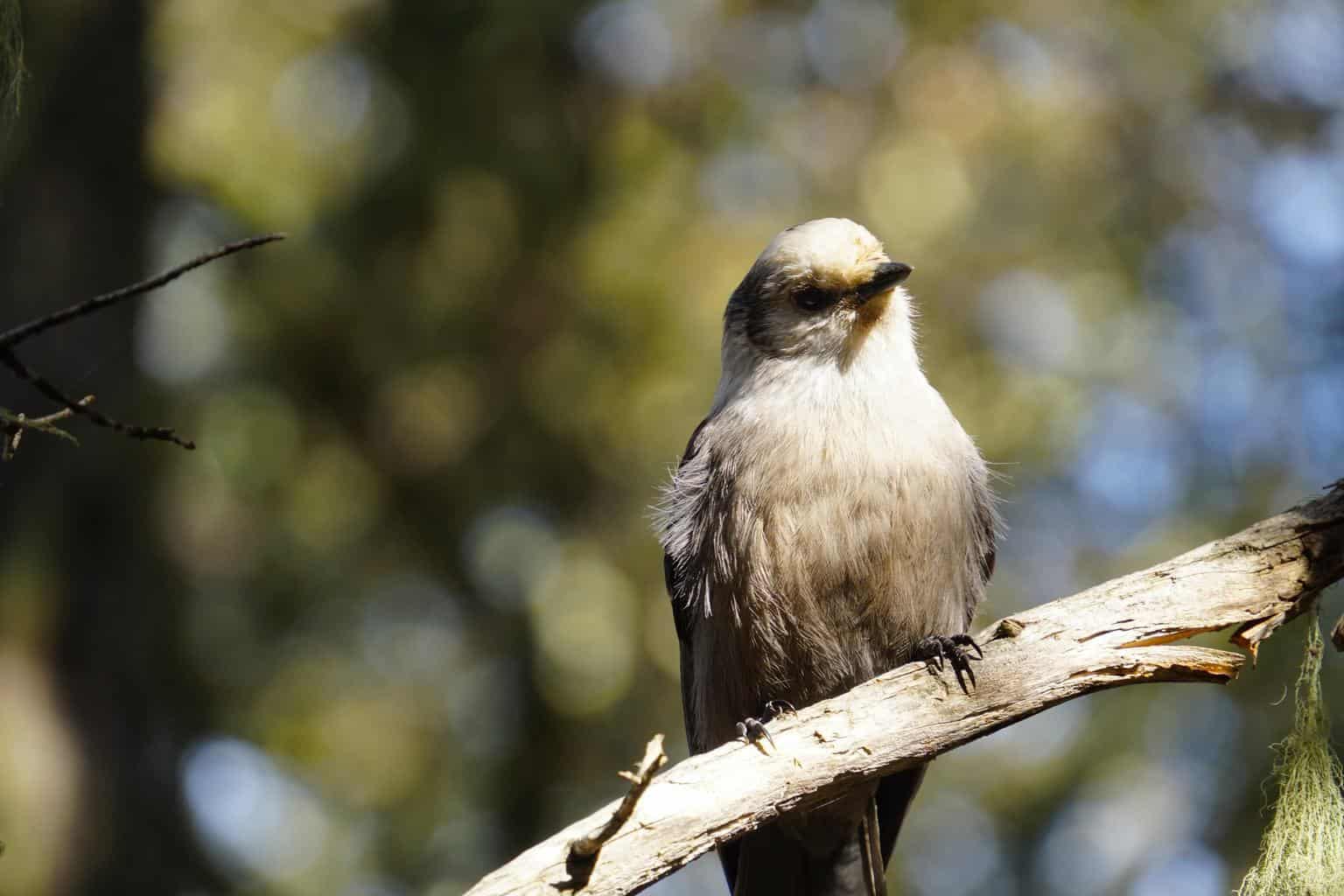
- Scientific name: Perisoreus canadensis
- Length: 9.8 – 11.4 inches
- Weight: 2.0 – 3.0 ounces
- Wingspan: 18.0 inches
The Canada jay is a large songbird with a short pointy bill. They’re dark gray on the back, and light gray underneath. They also have a black spot on the back of their heads. Young Canada jays are grayish-black all over.
These birds have a range of vocalizations and hoots. They fly in small flocks and accept a variety of different foods from hikers, like berries and carrion. They also enjoy scavenging for carrion.
Tufted Puffin

- Scientific name: Fratercula cirrhata
- Length: 14.2 – 15.8 inches
- Weight: 18.3 – 35.3 ounces
- Wingspan: 25.6 inches
This is a stocky seabird with a beautiful color combination. Breeding adults have a white face and yellow plumes on the back of their heads. They also have a big, triangular red and orange bill. Non-breeding birds are dark all over, with a dark gray face.
These birds mostly feed on small fish and mollusks. They also eat crustaceans and cephalopods.
Bald Eagle

- Scientific name: Haliaeetus leucocephalus
- Length: 27.9 – 37.8 inches
- Weight: 105.8 – 222.2 ounces
- Wingspan: 80.3 inches
This is the eagle that appears next to the US flag. It’s a large raptor with a heavy body, a large head, and a huge wingspan. Adult eagles have white heads and yellow bills that curve downward into a sharp point, resembling a hook. They have bright yellow legs and a white tail. Younger eagles have darker heads and tails.
You’ll likely spot this eagle soaring high in the sky. They spot freshly hunted prey and fight the predators for it or may feed on leftover carcasses. They also hunt fish and small mammals.
Conclusion
Alaska is home to countless bird species, some of which may not have even been discovered yet! And since most people go to Alaska for touristic endeavors to enjoy its breathtaking views, they will almost certainly bump into some of the birds mentioned above.
As a general rule of thumb, you may want to visit Alaska during the spring. This is the time when most birds flock back to land. Also, keep a few berries with you for when you meet a welcoming host!

